MARIANI’S
Virtual Gourmet
March 25,
2019
NEWSLETTER
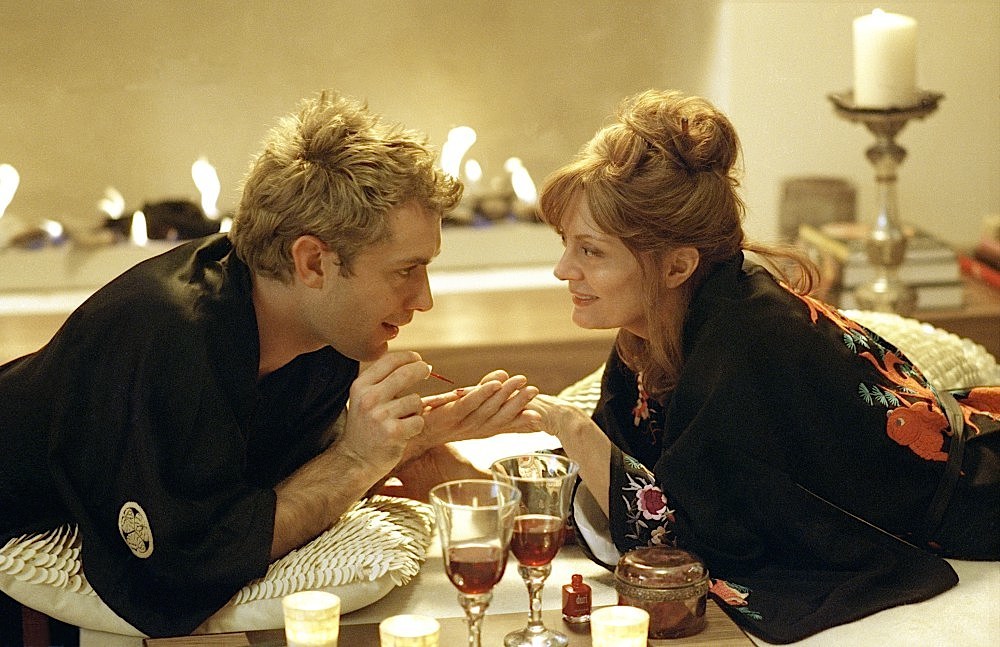
❖❖❖
IN THIS ISSUE
DINING OUT IN THE BAHAMAS, Part Two
By Geoff Kalish
NEW YORK CORNER
Zhen Wei Fang
By John Mariani
THE CHALLENGES OF SELLING ITALIAN WINE TODAY:
AN INTERVIEW WITH TARA EMPSON
By John Mariani
❖❖❖
DINING OUT IN THE BAHAMAS
Part Two
By Geoff Kalish
DOWNTOWN &
PARADISE ISLAND
Café Matisse
Bank Lane
242-356-7012
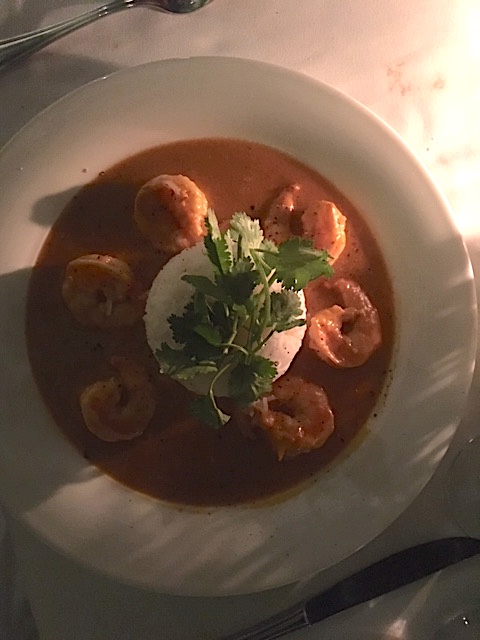
Located
just behind Parliament Square, this has been a
very popular spot with upscale locals and
tourists for almost a quarter of a century.
It serves well-made, primarily Italian fare in a
100-year-old building featuring a number of small
rooms decorated with Henri Matisse prints and
cut-outs and a charming outdoor courtyard
reminiscent of many in New Orleans and Provence.
From a choice
of a dozen appetizers we shared a thick slice of
tasty parmesan terrine served with a green salad
topped with pine nuts and dressed in a good
vinaigrette, and an order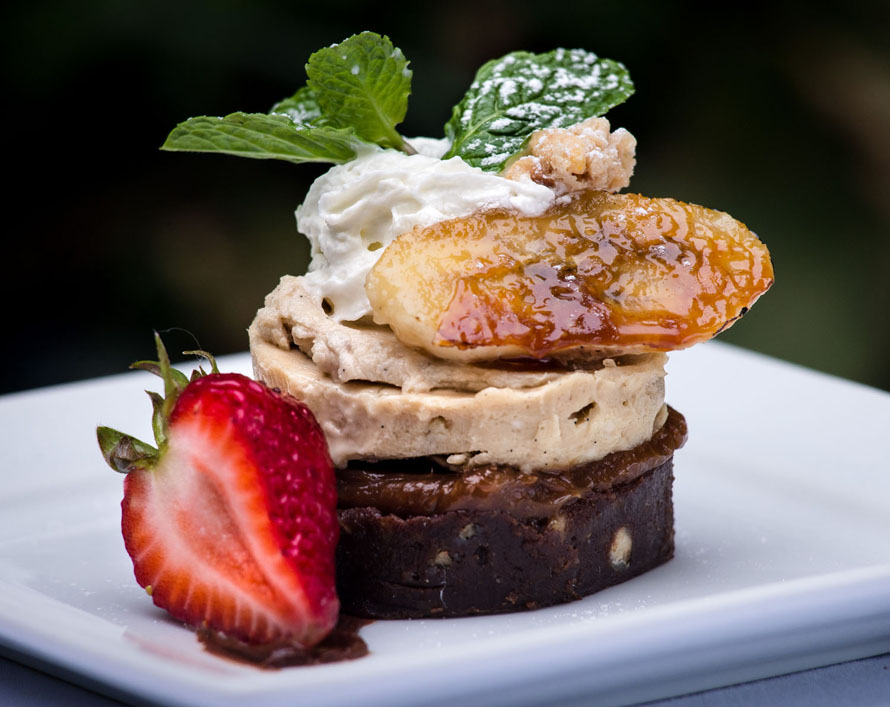 of
octopus salad, with juicy slices of the cephalopod
served with a mix of radicchio and chickpeas
spiced with fresh, minty marjoram.
The flavor of a main course of
grilled grouper fillet benefited from a dousing
with citrus sauce and was served atop a heap of
buttery mashed potatoes. And in an order of prawns
in a red curry sauce (left), the large, fiery
crustaceans were surrounded by flavorful jasmine
rice. For dessert we enjoyed a slice of decadently
rich black and white chocolate cake served with
strawberry sauce (right).
of
octopus salad, with juicy slices of the cephalopod
served with a mix of radicchio and chickpeas
spiced with fresh, minty marjoram.
The flavor of a main course of
grilled grouper fillet benefited from a dousing
with citrus sauce and was served atop a heap of
buttery mashed potatoes. And in an order of prawns
in a red curry sauce (left), the large, fiery
crustaceans were surrounded by flavorful jasmine
rice. For dessert we enjoyed a slice of decadently
rich black and white chocolate cake served with
strawberry sauce (right).
From
a wine list offering a number of sensibly-priced
(for the Bahamas) bottles we chose
a fruity, cassis-scented
Chapelle de la Trinité from St. Émilion, which
matched well with the grouper but was overwhelmed
by the heady spice of the prawns. Of note, service
was timely and professional, overseen by owner
Gregory Curry.
Open
Tuesday-Saturday for dinner. Expect dinner for
two to cost $130 - $140, not including wine, tax
or tip.
Graycliff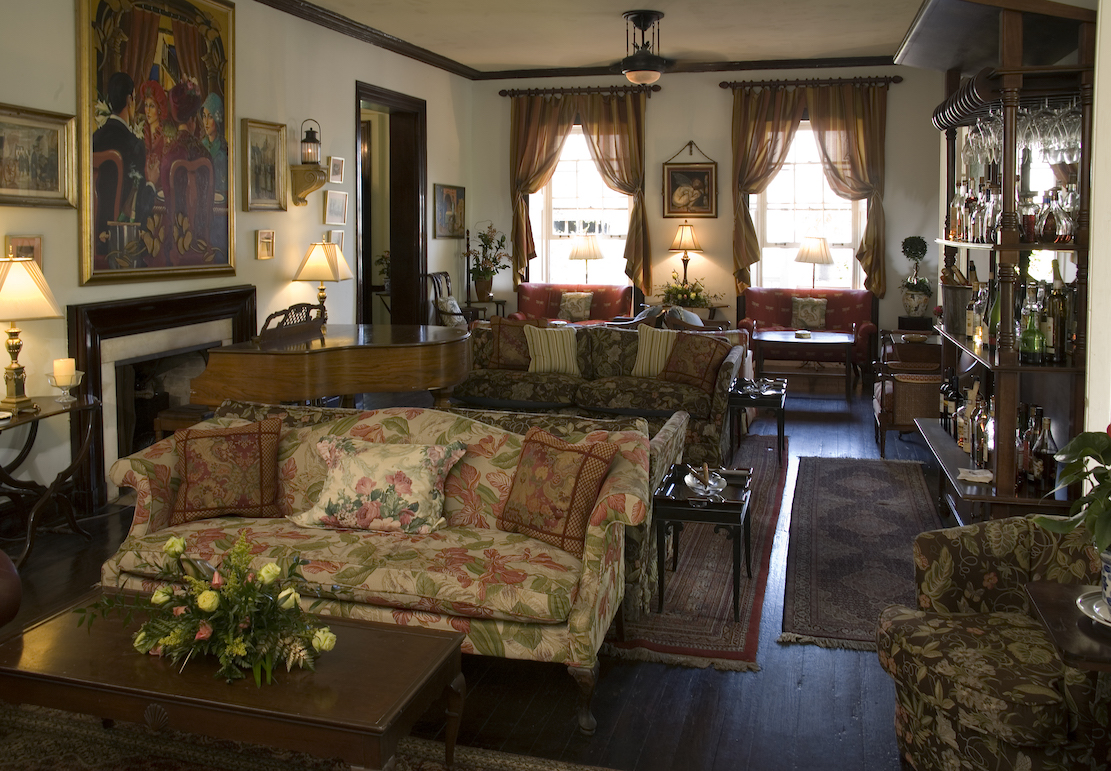
West Hill Street
242- 302-9150
Not for the
faint-of-wallet, this historic Victorian house
on a hill overlooking the downtown area
features a wine cellar of 275,000 bottles (the
third largest private cellar in the world).
It’s the brainchild of
charming, long-time owner Enrico Garzaroli, who
purchased the decaying property in 1973 and
restored it into an elegant hotel and restaurant.
Upon entering,
patrons are seated first in an art museum-like
anteroom for aperitifs, where menus and wine
selections are presented. You are then escorted by
an experienced staff member to one of a number of
individual Old World-styled rooms with
white-clothed tables, fine china, silverware and,
of course, exquisite wine glasses.
The fare
offered (soon to change a bit with the hiring of a
Michelin-starred chef, Garzaroli confided) is a
mélange of French and Italian classics. For
example, appetizers run the gamut from mozzarella
di bufala à l’Italienne to a brochette of snails
with sauce bourguignonne. Main courses
range from branzino à l’acqua pazza to raviolacci
au langouste et tomates. We
chose as appetizers a slice of Bahamian lobster
tail set atop tasty greens and a small puff pastry
adrift on a saffron-infused cream sauce, and a
quinoa salad served with a dice of fresh
vegetables, enlivened with an olive oil
vinaigrette. For main courses we selected moist
morsels of Bahamian lobster baked in its shell
with a smooth, flavorful white wine tomato sauce,
and a large veal tomahawk steak coated with a
reduction of earthy mushrooms and truffles. We
concluded with a selection of excellent cheeses
served with thick honey. For wine the owner
selected for us a bottle of the very popular 2015
Robert Foley “The Griffen” blend, which showed
rich flavors of plums and strawberries with a bit
of tannin in its finish.
Open daily for
dinner. Expect dinner for two to cost $180 -
$200, not including wine, tax or tip.
Dali
Modernistic Tapas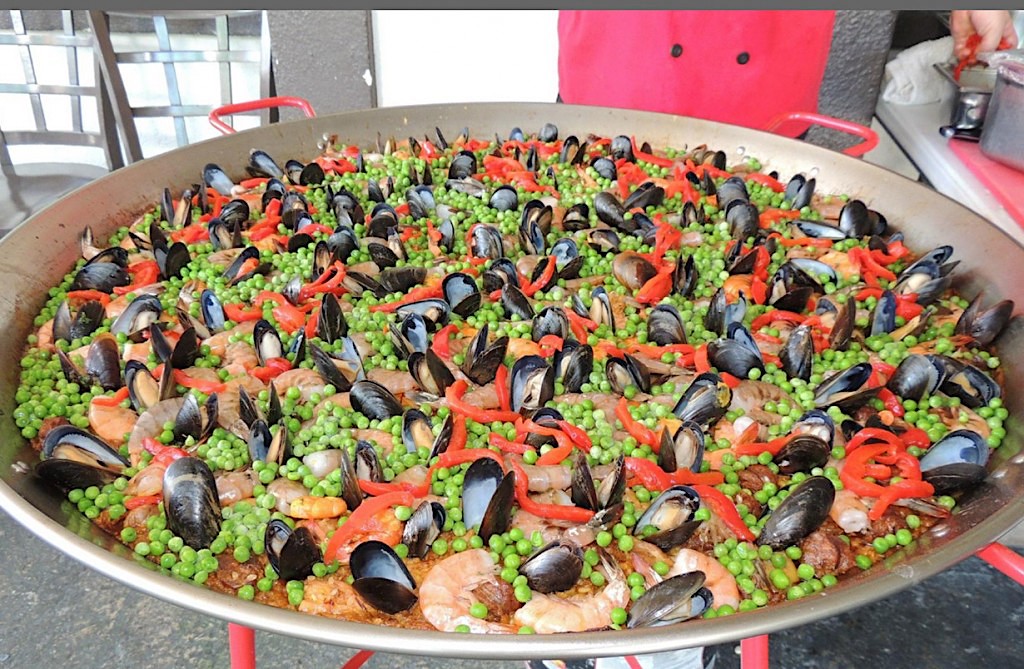
#1 Bay Street, Navy Lion Road
242-698 2008
At this proverbial
“hole-in-the-wall” storefront, surprisingly
little known even by savvy locals, chef-owner
Werner creates excellent takes on traditional
fare. Service by a knowledgeable staff
takes place in a small indoor room with a bar down
one side and a brightly painted yellow wall
covered with Salvador Dali prints and dollar bills
(with notes from previous diners) down the other
side. There is also an outside courtyard and a
small space in front of the eatery.
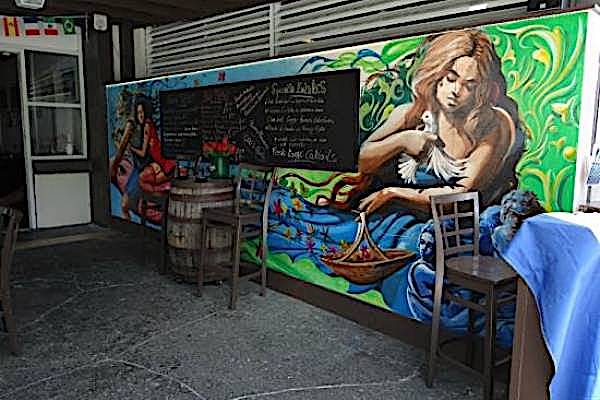 From a choice of more than two dozen tapas, we
shared orders of piping hot conch fritters that
were crisp, a bit sweet and crunchy on the inside
($9.50); garlicky gambas ajillo ($14) as well as
sizzling, fiery pil-pil gambas ($14), both shrimp
dishes made with tender crustaceans and good olive
oil. For main courses, from a list of more than a
dozen choices, we selected an artfully presented
special of grilled red snapper fillet with a
variety of peppers ($21). The highlight of
the evening— from a selection of individual bowls
of paella ($28)—was one of rich, briny shrimp and
calamari sautéed with saffron rice and black squid
ink (above).
From a choice of more than two dozen tapas, we
shared orders of piping hot conch fritters that
were crisp, a bit sweet and crunchy on the inside
($9.50); garlicky gambas ajillo ($14) as well as
sizzling, fiery pil-pil gambas ($14), both shrimp
dishes made with tender crustaceans and good olive
oil. For main courses, from a list of more than a
dozen choices, we selected an artfully presented
special of grilled red snapper fillet with a
variety of peppers ($21). The highlight of
the evening— from a selection of individual bowls
of paella ($28)—was one of rich, briny shrimp and
calamari sautéed with saffron rice and black squid
ink (above).
We accompanied
the meal with a bottle of plum- and
cherry-flavored Torres Gran Sangre de Toro Reserva
and concluded with a lavish strawberry shortcake
crêpe.
Open
Monday-Saturday for dinner. Expect dinner for
two to cost $100 - $110, not including wine, tax
or tip.
Paradise
Island Dining
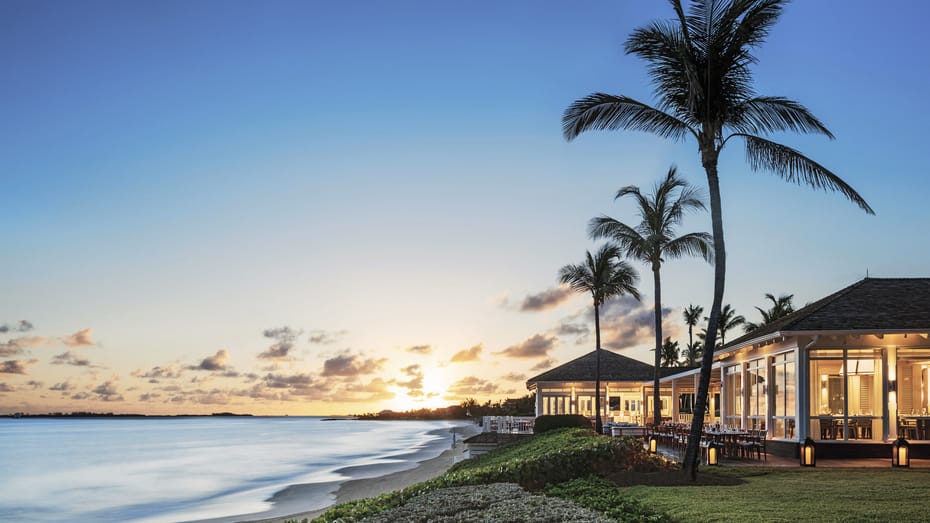
The Ocean Club Four
Seasons Hotel
Dune
One Ocean Drive
Ocean Club The Four Seasons Hotel
242-363-8737
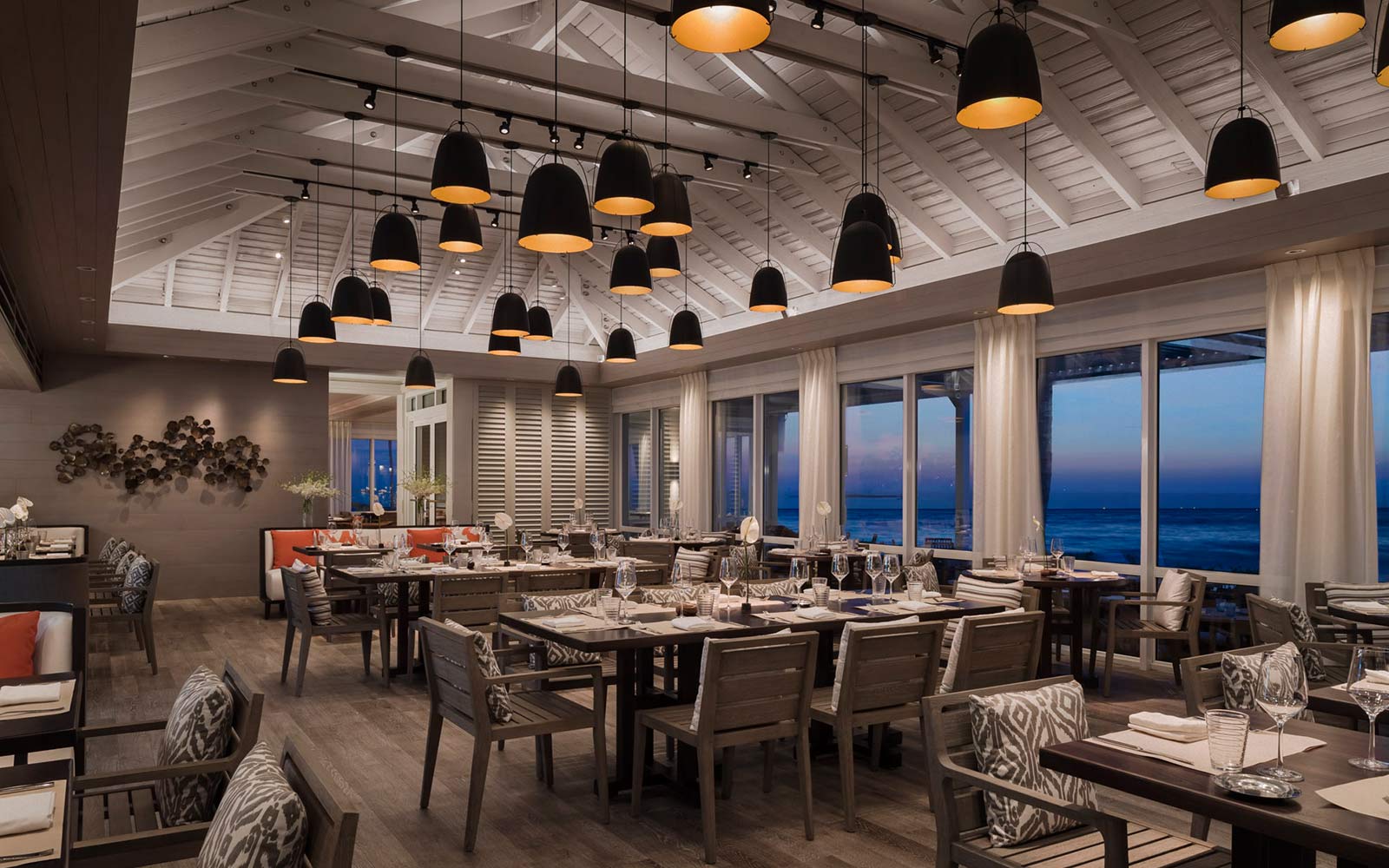
Why
would we travel from New York to Paradise Island
to eat at a Jean-Georges Vongerichten
restaurant? First, there’s the setting atop
a bluff, so that evening diners are serenaded by
the waves crashing against the rocks below. Also,
we can taste his signature yellowfin tuna tartare
($29) and shrimp salad with the whole crustaceans
topped with a lemony sabayon and surrounded by a
mound of greens and avocado dressed with a
Champagne vinaigrette. 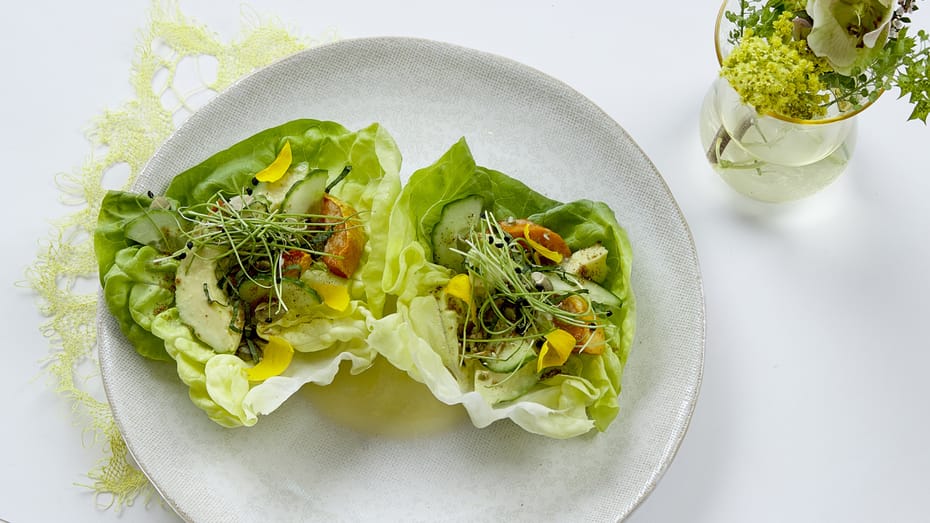
But there are
numerous other excellent dishes you’ll not
encounter at any of his Manhattan outposts. For
example, there are appetizers of fresh local
lobster served with a passion fruit mustard;
shrimp satay accompanied by a pungent sweet and
sour sauce ($26); and a wide selection of
noteworthy main courses like local lobster served
with a heady but light curry sauce and accompanied
by fried plantains and sautéed bok choy ($62).
There’s also a classic roast duck breast served
with a shallot confit, shitake mushrooms,
asparagus and a tasty lotus root stir fry ($52).
And for
dessert, in addition to Jean-George’s well-known
warm chocolate cake with a molten center, served
with coconut sorbet, there are a number of other
interesting choices like a passion fruit sunflower
served with orange blossom cream and meringue.
We accompanied
the meal with a bottle of 2014 Edmeades Zinfandel
that had bold flavors of ripe plums, mint and
other earthy spices.
Open daily for
lunch and dinner. Expect dinner for two to cost
$160-$170, not including wine, tax or tip.
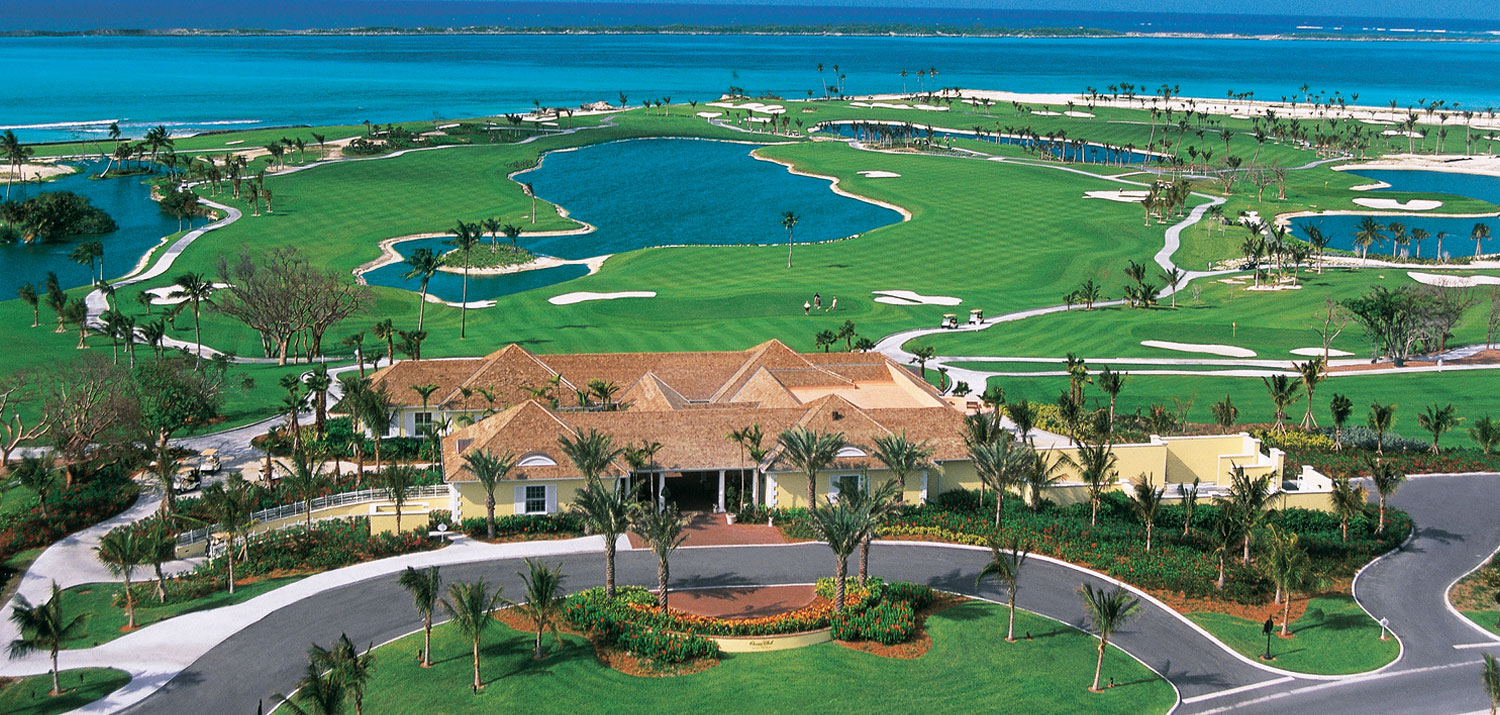 Golf on
Paradise Island
Golf on
Paradise Island
The
18-hole, par-72 Ocean Club Golf Course, designed
by Tom Weiskopf and managed by Troon Golf, plays
7,100 yards from “the tips” and features scenic
views of the ocean alongside a number of
fairways and behind a few of the greens. And
even with rather wide fairways and fairly
straightforward greens, we found the course
quite challenging, with local knowledge needed
for placement of drives and, especially,
approach shots. Also, while it was in excellent
condition, we found that with its numerous
majestic homes alongside many of the fairways
and relatively flat terrain, it was not
dissimilar to any number of upscale Florida
courses. In addition to
the usual clubhouse amenities, a well-stocked pro
shop and casual dining facility, the club offers
rentals, an excellent practice area and a golf
academy for players at all levels.
The 18-hole rate is $295
January–April and slightly less at other times,
with play restricted to guests of the Atlantis
and Four Seasons hotels and Troon Club members.
❖❖❖
By John Mariani
ZHEN WEI FANG
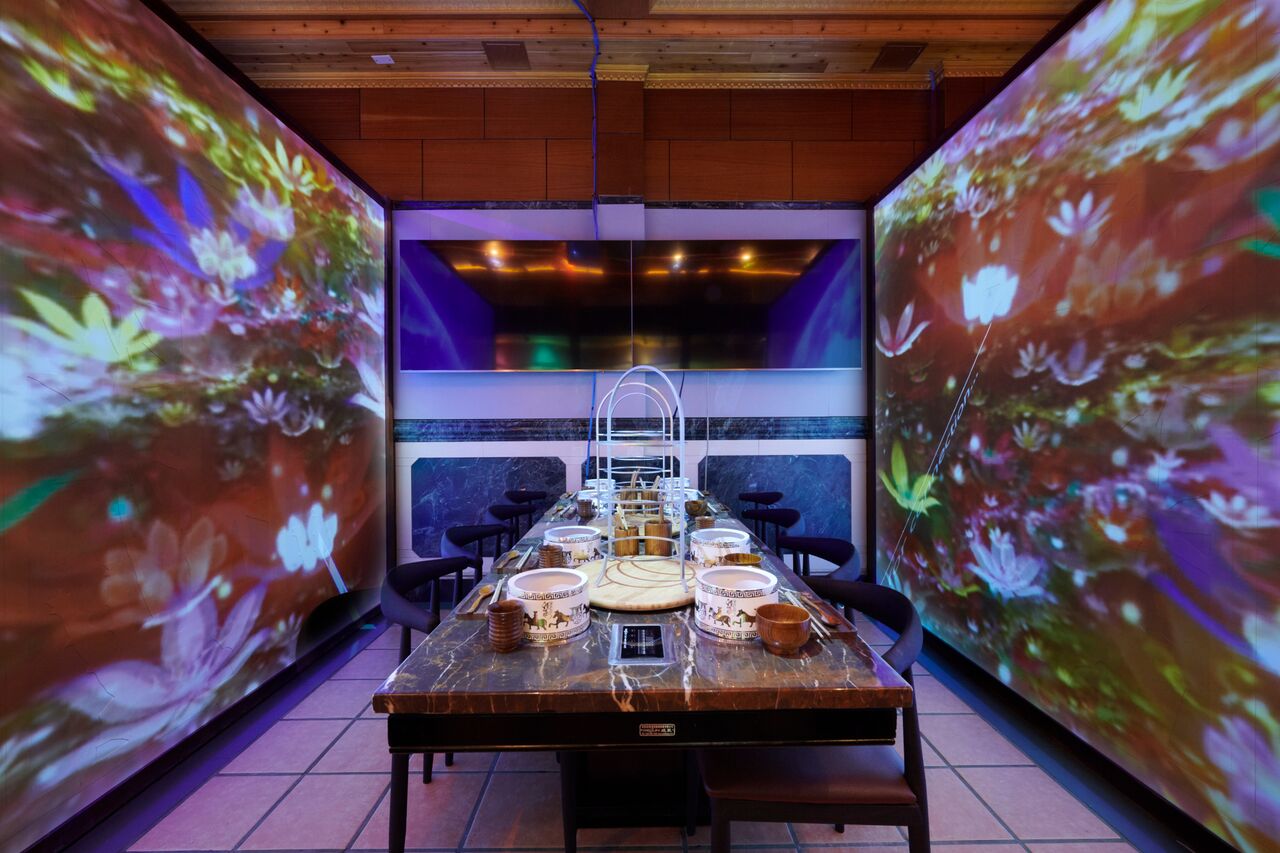
New
York
is not exactly flush with hot pot-style
restaurants, and those that do exist, like
Mister Hotpot in Brooklyn 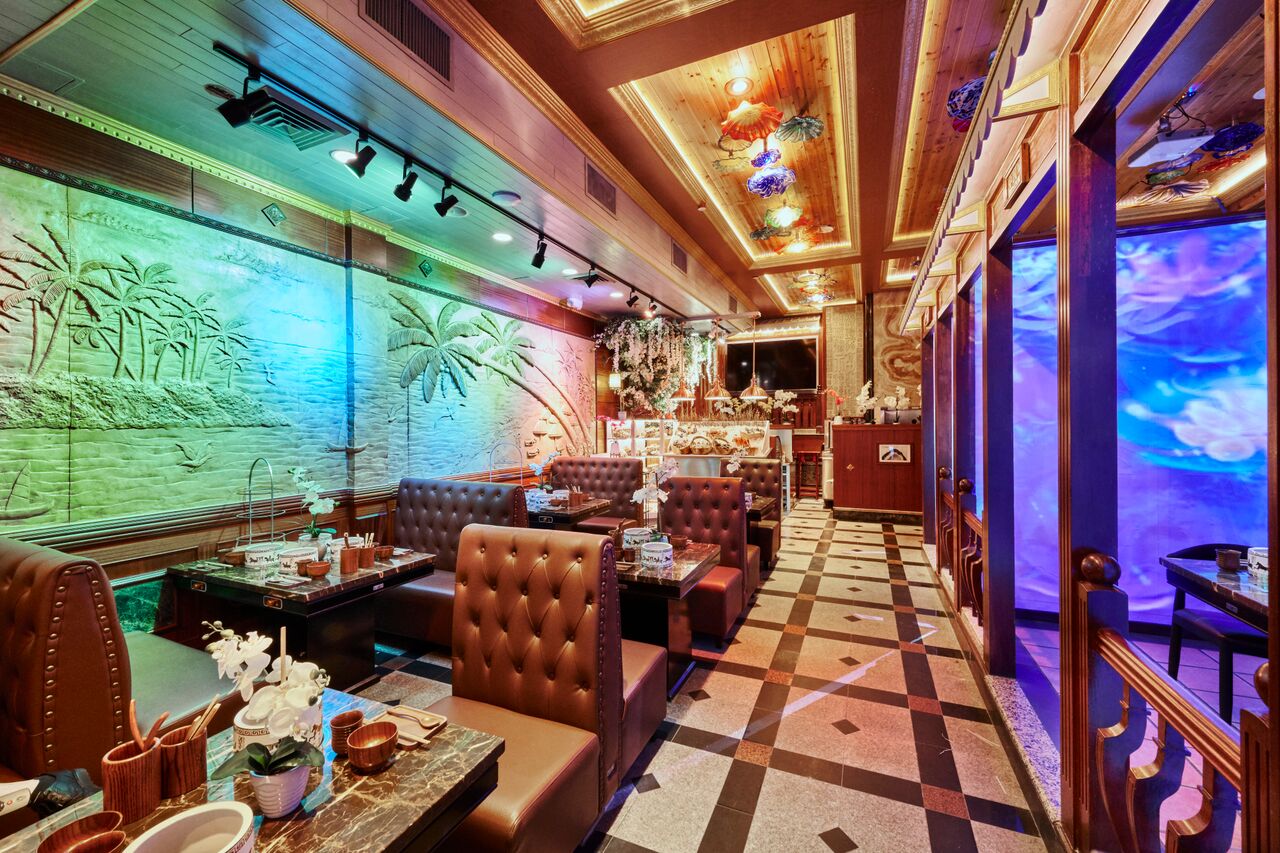 and Hou Yi in the East
Village, are modest, all-you-can-eat spots. Zhen
Wei Fang, on the other hand, brings a unique,
even extravagant style to the genre, starting
with a Mandarin-speaking greeter that happens to
be a big white robot.
and Hou Yi in the East
Village, are modest, all-you-can-eat spots. Zhen
Wei Fang, on the other hand, brings a unique,
even extravagant style to the genre, starting
with a Mandarin-speaking greeter that happens to
be a big white robot.
The 170-seat
room dazzles with Crayola colors, set on two
levels, with swirling psychedelic videos and Avatar
landscapes while pop music (not too loud) thrums
in the background.
Four huge TVs are showing Jackie Chan
singing, without sound. There are three
semi-enclosed rooms above the main dining area
that are delightful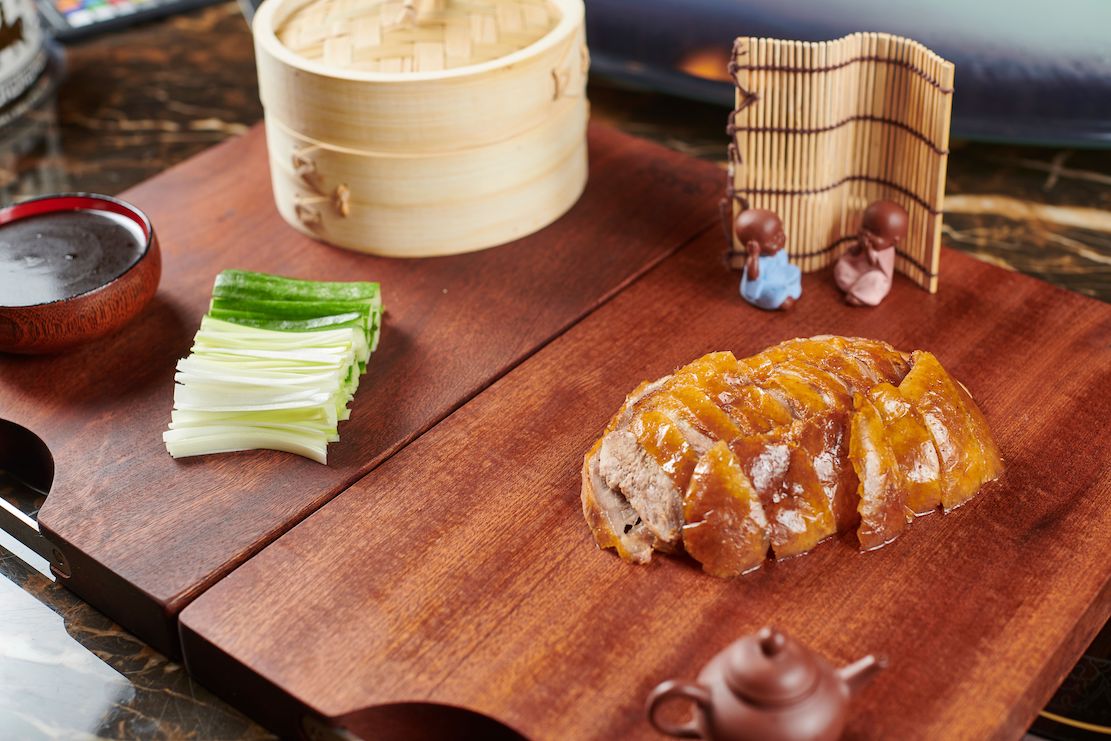 with a
party of four or more. Zhen Wei Fang’s owner, Wei
Chen, is out to tantalize all your senses, not
just your sense of taste. Zhen
means “finest,” wei means
“delicious.” Chef Wei Huang, from Guangdong,
oversees both the New York and the original Miami
locations.
with a
party of four or more. Zhen Wei Fang’s owner, Wei
Chen, is out to tantalize all your senses, not
just your sense of taste. Zhen
means “finest,” wei means
“delicious.” Chef Wei Huang, from Guangdong,
oversees both the New York and the original Miami
locations.
The menu is very long and somewhat confusing. There are three sections of hot, cold and house special appetizers, then hot pot sections of Chef’s Special, Special Meat Selections, Meat Dishes, Seafood, Pastes & Paste Balls, Organic Vegetables, Organic Mushroom & Fungi, Bean Curd and Wheat Flour Dishes. How’s a person to choose?
Let’s begin with the apps. Spicy bang-bang chicken ($7.99) lives up to its name, with the first bang coming from the fact that it’s unexpectedly chilled, the second that the chilies are very hot. “Pecking [sic] duck” (half $35, whole $65) is served as a first course, with its brittle skin and meat wrapped in Chinese pancakes at the table. A huge, meaty spicy Dungeness crab ($59.95) can serve four as a starter, and if you’re up for a pot of spicy frog ($24.99), go for it.
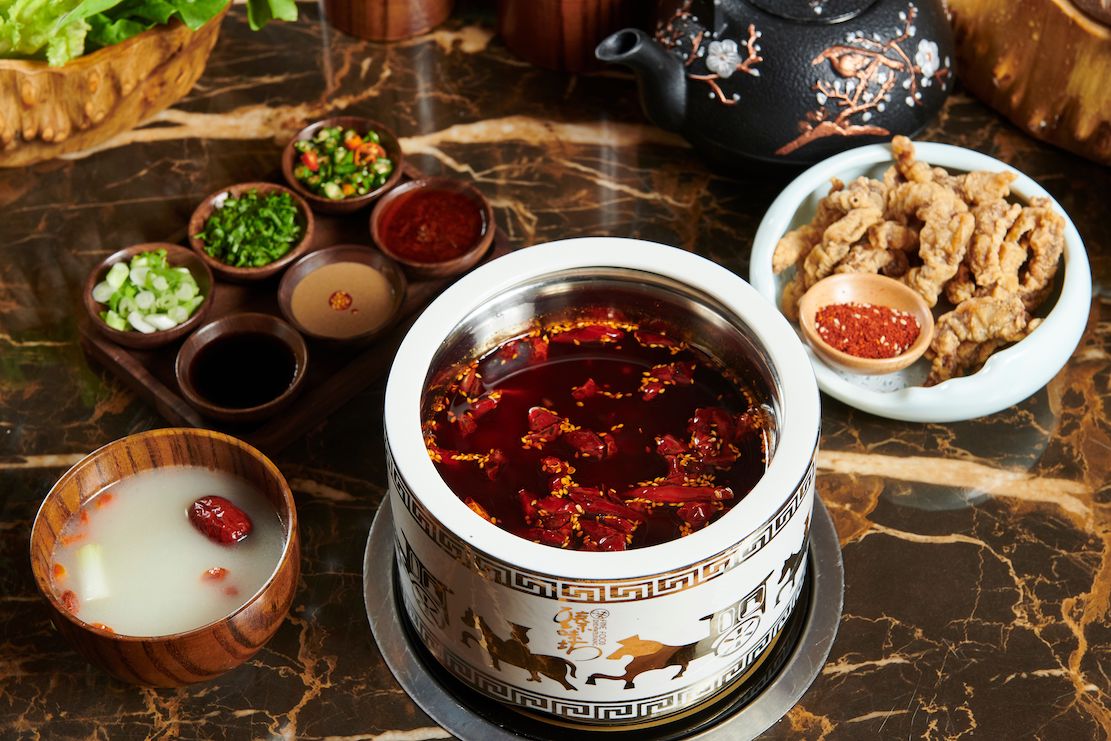 The
main event at ZWF is the hot pot of various
broths, with a soup base of Szechuan spicy,
herbal, beef bone, spicy tomato and others
($4.99-$5.99), into which you dip and cook a wide
array of items, along with a dipping sauce that
adds to the simple flavors of the cooked food. You
can be adventurous with five-spice braised pork
intestines ($5.99) or Chengdu skewers ($10.99) of
duck feet, intestines, pig’s blood, beef artery,
tripe, pork brain, and more offal. Otherwise,
there is New Zealand lamb ($8.99) and an
assortment of enoki and other mushrooms ($4.99).
The
main event at ZWF is the hot pot of various
broths, with a soup base of Szechuan spicy,
herbal, beef bone, spicy tomato and others
($4.99-$5.99), into which you dip and cook a wide
array of items, along with a dipping sauce that
adds to the simple flavors of the cooked food. You
can be adventurous with five-spice braised pork
intestines ($5.99) or Chengdu skewers ($10.99) of
duck feet, intestines, pig’s blood, beef artery,
tripe, pork brain, and more offal. Otherwise,
there is New Zealand lamb ($8.99) and an
assortment of enoki and other mushrooms ($4.99).
There is, of course, the now requisite wagyu beef
(below),
and the better way to 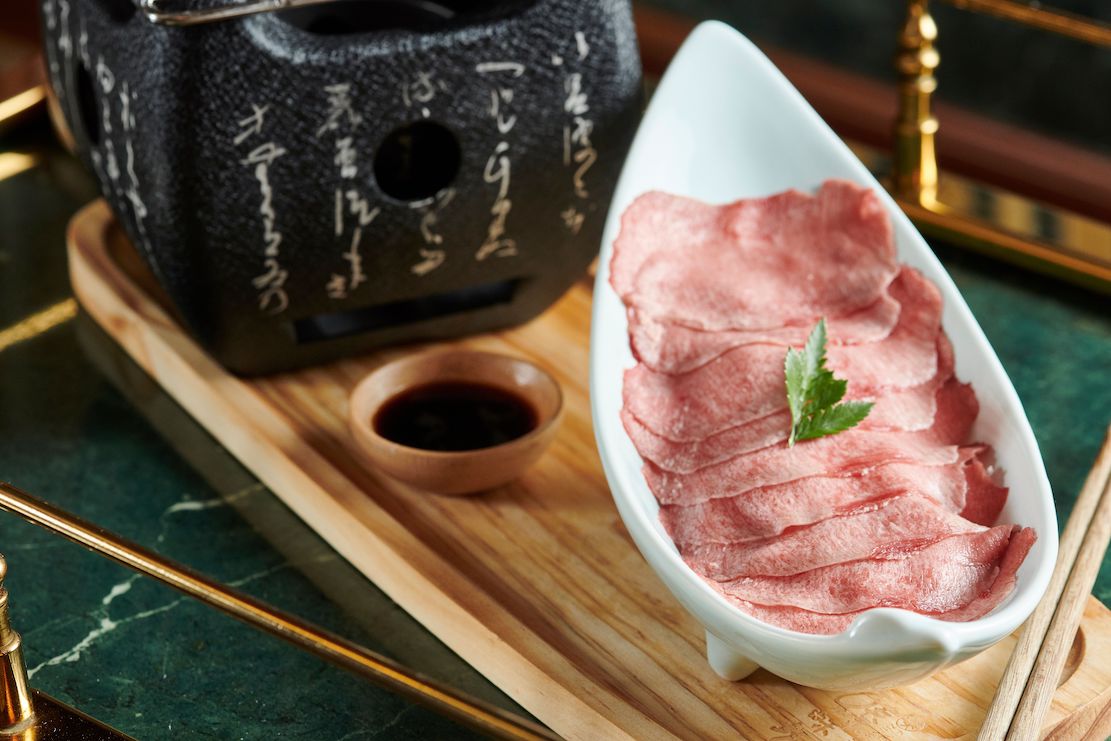 have it is sliced ($79.95) rather
than the ice-cold beef cubes ($26.99). One of the
very interesting pastes is cuttlefish ($9.99),
which is somewhat viscous and not at all
fishy-tasting. There are even ten tofu selections
to choose among, and the dumplings ($3.99-$7.99)
are delicious when briefly dunked into the hot
pot.
have it is sliced ($79.95) rather
than the ice-cold beef cubes ($26.99). One of the
very interesting pastes is cuttlefish ($9.99),
which is somewhat viscous and not at all
fishy-tasting. There are even ten tofu selections
to choose among, and the dumplings ($3.99-$7.99)
are delicious when briefly dunked into the hot
pot.
At the very end of the main section of the meal, you get rice, which, frankly, you’ll be very happy to have because all those proteins that went before might fail to fill you up, and that little bowl of steamed carbs will help round out the meal.
There is only one kind of dessert, though available in several flavors—a “dream pop” of ice cream or sorbet ($5.99), which is refreshing if not in a league with Ben & Jerry’s.
In New York, then, Zhen Wei Fang is unique on several counts, certainly for its spectacle and party vibe but also for the quality of its ingredients and variety that makes it a special night out downtown.
Open for lunch Thurs-.Sun., for dinner daily.
❖❖❖
THE CHALLENGES OF IMPORTING
AND MARKETING ITALIAN WINE
AN INTERVIEW WITH
TARA EMPSON
By John Mariani
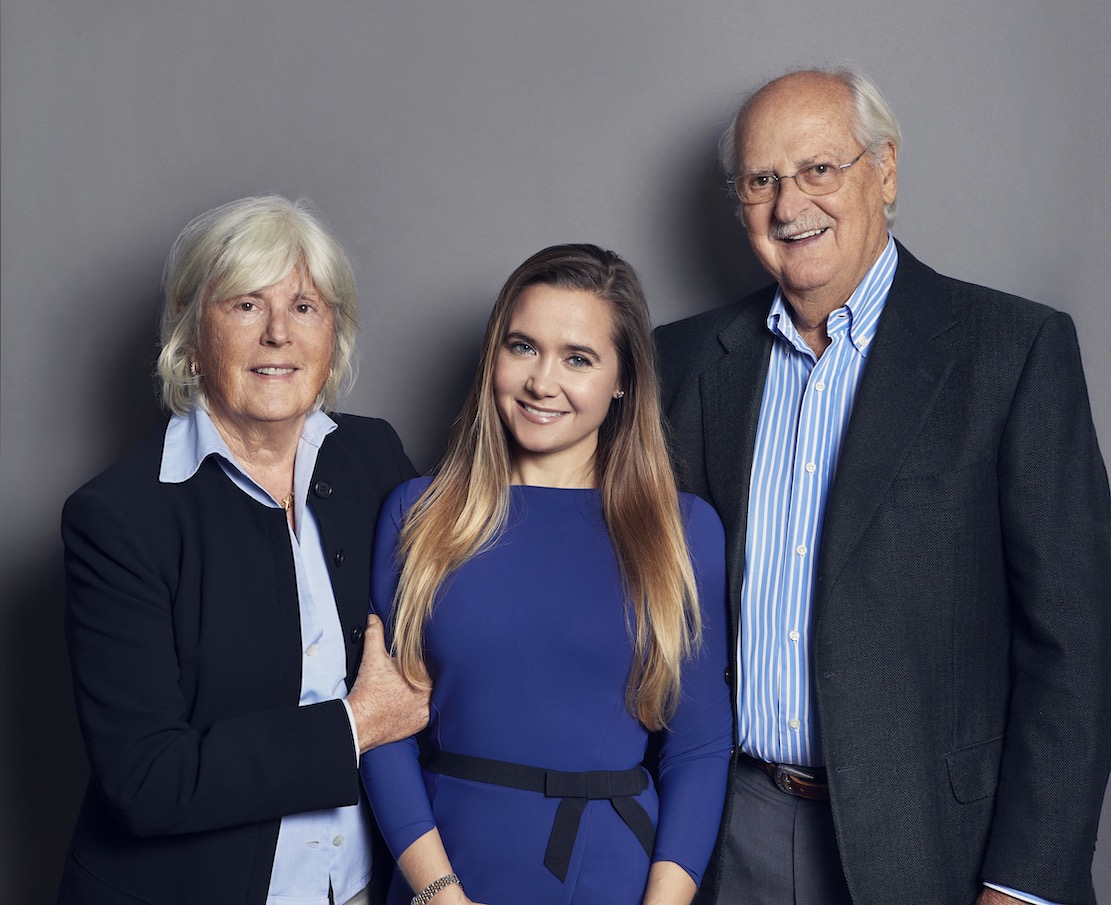
Maria, Tara and Neil Empson
For
nearly a half century Empson &
Co. has championed fine Italian wines in
the United States and around the world.
Founded by Neil and Maria
Empson in 1972, when most Americans
knew nothing but Chianti, Valpolicella and
Soave , the importer was the first to
bring in the highest quality wines from
names like Gaja, Marcarini, Sassicaia,
Conterno Fantino, Boscarelli and dozens of
others, now with operations in all 50
states and 28 countries.
Last September
Neil Empson appointed their daughter
Tara, 34, to succeed him in his role at
Empson & Co., and, as of April 1,
Empson USA. I sat down with Tara
over dinner at an Italian restaurant in
New York and asked how the business of
importing and distributing wine has
changed in the past decade.
Your
parents have seen the enormous growth of
Italian wine worldwide since 1972.
What factors in that decade contributed the
most to success? What
did the family do in those early days to
change the image of Italian wines?
The selection of wines was
very limited in the market, as the French had
marketed themselves and their
wine in an impeccable manner. My parents’
struggle was to go out there and
teach about Italian wine diversity and
potential of quality at a time in which
the best vineyards were often owned and sold
locally by small farmers. They
dedicated their life to traveling (as they
began as brokers prior to Empson USA
being founded in 1991) and established
connections and relationships with their
various clients and with this also trust in
selecting and importing “fine”
Italian wine.
My parents
were amazing at seeing the potential
in the wines that they decided to represent
and with that they entered the
market with iconic names such as Sassicaia and
Gaja. Their interest was not in
mass production but in qualitative production.
One of the principal
factors to the early success was in their
selection of wines that were both
intrinsic to the Italian culture and cuisine,
while also made with such
elegance that these wines — while very
different from most being offered from
other countries – were also suitable to the
international market.
Your website reads: "At Empson
& Co. …
family, integrity, leadership,
and authenticity are the four key
strengths that have enabled the Empson
Company to establish its
standout positioning as a pioneer in exporting
fine Italian wine worldwide.” What
are the ways these strengths have dealt with a
wine world composed of giant corporations
and a reputation for toughness that goes back
to Prohibition?
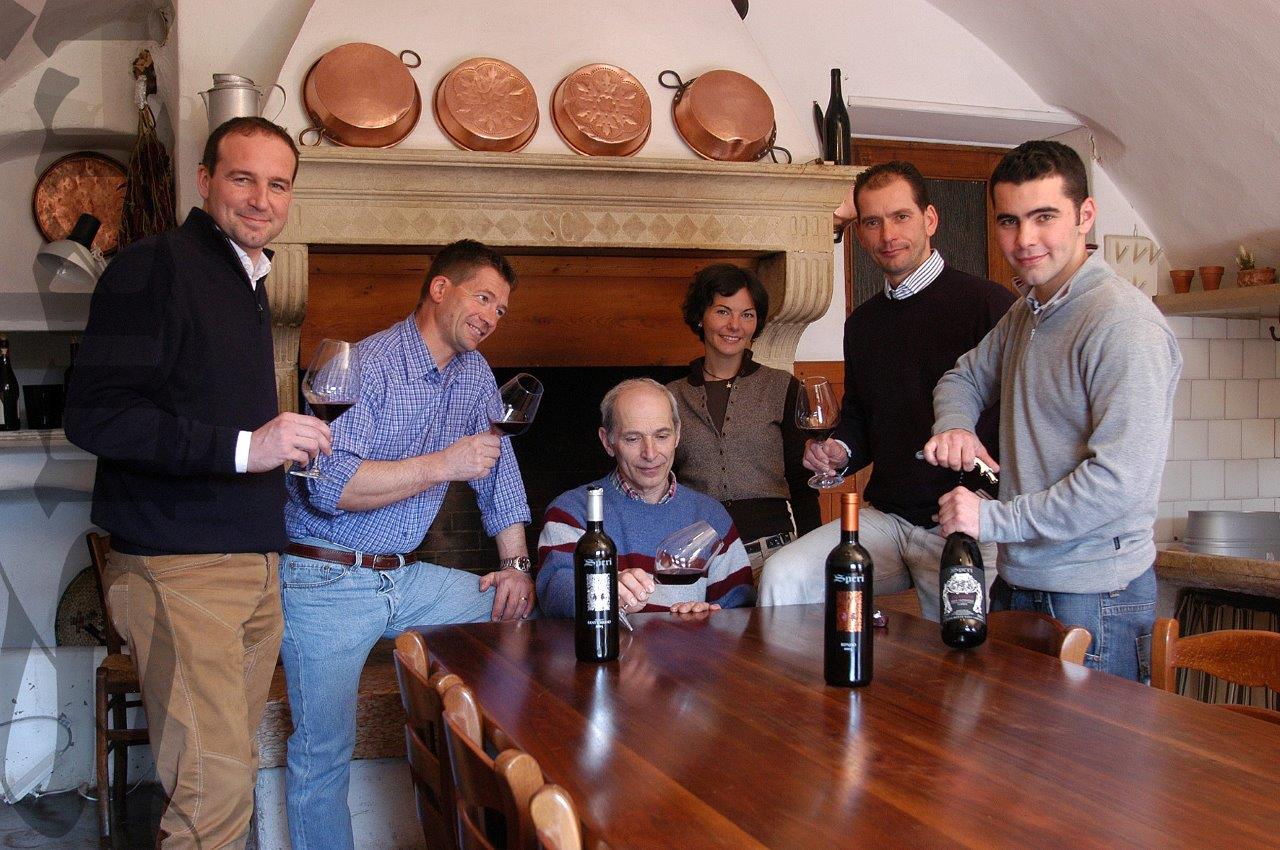 Our
relationships and the wineries we partner with
have defined who
we are. We have always gone above and beyond
business by supporting and
investing with our partners where we
could. Life is not just about celebrating the
good times, it’s also about weathering
out the “less than ideal” times and
this is a valuable lesson my parents taught
me. We are known for celebrating
many years of partnerships with our
wineries and we
have many in our portfolio that
are well beyond 30 to 40 years, like the
generations of the Speri family of the Veneto
(left).
Our
relationships and the wineries we partner with
have defined who
we are. We have always gone above and beyond
business by supporting and
investing with our partners where we
could. Life is not just about celebrating the
good times, it’s also about weathering
out the “less than ideal” times and
this is a valuable lesson my parents taught
me. We are known for celebrating
many years of partnerships with our
wineries and we
have many in our portfolio that
are well beyond 30 to 40 years, like the
generations of the Speri family of the Veneto
(left).
We
still very much believe in the “human touch”
wherein everyone can be involved
in making a difference. Lastly, most of our
wineries are family owned and run.
We value this very much as we ourselves are a
family-run company and we understand
the values and sometimes the struggles that
come with the necessity to grow and
always
try to improve.
We
know
that the power of marketing, when it comes to
large corporations, is
difficult to compete with, so we target a
different route to market, preferring
clients who understand the value of hand
selling, story telling and
relationship building.
Explain simply
how the selling and buying of
wine works, i.e., how does a wine estate in
Italy sell its wine abroad and what
role do importers and distributors play?
What role do state wine laws play in
the U.S. as to what may be imported?
The uniqueness and difference of
the U.S. market lies in the fact
that it is one country but each state has its
own taxes, laws and requirements.
This situation many times acts as if we were
dealing with 50 different
countries rather than a single entity, so the
back office and bureaucracy can
be very extensive for any importer.
Importers
have
a distinct and select portfolio of wines that
they choose to develop and
promote. They hold the relationships and
choose to co-invest when needed to
support that same portfolio. Importers’
selections traditionally are based on
similar vision
and ideology with their
winery partners. There are many new importers
each year in the market as the
wine selections are more numerous and the need
for a strong representation
through a reputable importer is
more essential than ever.
Distributors
hold
most of the inventory needed to supply retail
stores and restaurants on a
daily basis.
These days, inventory
at distributors’ warehouses can be very tight,
with a much greater need for a
highly efficient logistics operation on the importers’
side to reduce times a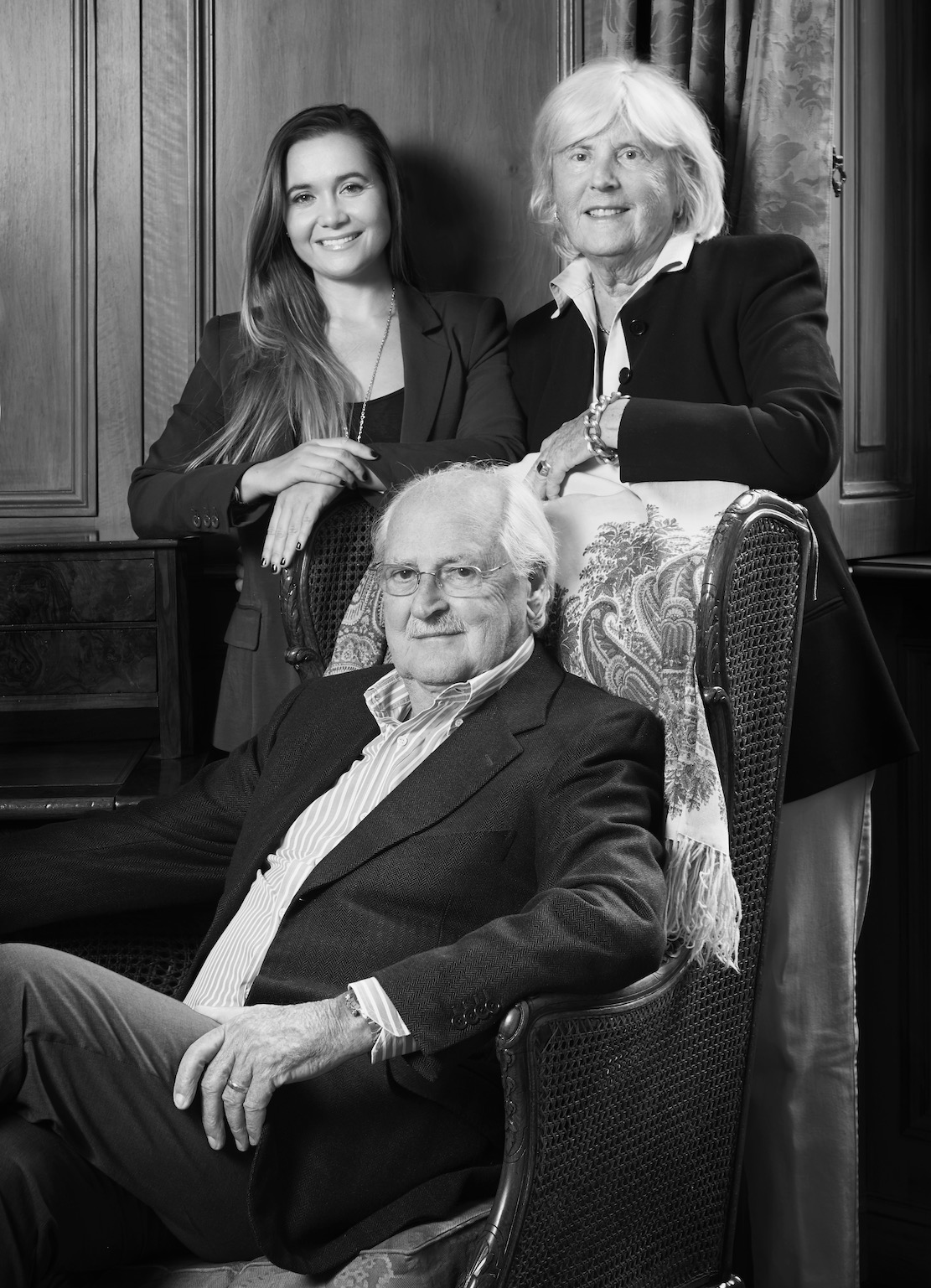 nd to
try to prevent retailers and restaurants from
running out of supply. This is
just one of the many important services that
good importers perform for their
distribution network.
nd to
try to prevent retailers and restaurants from
running out of supply. This is
just one of the many important services that
good importers perform for their
distribution network.
If a
winery sells a wine to an importer for, say,
$10, why does it cost what it
does, eventually, in a wine store? In a
restaurant?
It
all depends on the kind of representation the
winery has, which route to market
the winery employs, what kind of exchange
rates can be secured and for how
long, how many markets the winery wishes to be
in, and what kind of investments
are available or agreed upon to support the
wineries. It is also important to
take into consideration how long the
distribution chain needs to implement
programming . Prices can vary 20-40% in states
that
are right next to each other. So with so many
variables, even within the
individual winery selection of a portfolio,
it’s very hard to give a formula to
arrive at a price for all wines. Generally, a
wine shop will sell it for $28-$30.
The
global wine market is
huge and hugely competitive, with far too
many wines trying to gain market
share at any one moment. Do some nations make
it difficult, as with import
taxes and quotas, to sell wines in their
countries?
Yes, of course, but then again
there only recently has been a will
to invest heavily in other
markets other
than the United States. Many countries, like
certain states within the U.S.A.,
actually are controlled by the
state with a monopoly system that makes all
the decisions for all wines being
bought and distributed. While
difficult
to enter in many cases, it does offer both the
producer and consumer
a fairer “playing field,” with wines more
often gaining visibility due to a
genuine price-quality ratio rather than thanks
to large marketing support
programs.
Up
until
the crisis of 2008-2009 the U.S.A. was
considered the prime market for many wines
out of Italy (as it still is), but
when things took a turn wineries understood that
they had to put their eggs in more than one
basket and also think of their
financial growth
and stability. Many
markets do not import as many wines as the
U.S.A. does and
the market layout is very different and
at
times very expensive.
If a
wine store owner or restaurateur finds a
wine from a small estate in Italy, how
does he arrange for it to be brought into
the U.S. and what minimum quantity is
required?
It depends on the structure of
the winery and what arrangements they
have set up for
importation into the
U.S.. If they have a good relationship with
their importer, the importer
can arrange through its distributor to
bring the wine in for the specific account. There are,
however,
several factors that always have to be
considered before doing this: getting
U.S. TTB [Alcohol and Tobacco Tax and
Trade Bureau] approval for the label;
calculating production and shipment
timing, and having the security that the
restaurant will fulfill their side of
the arrangement. Minimum quantities also
depend heavily on the size of the
winery, the distributor and the volume that
the account can sell though.
Obviously
the best-known labels can sell for
exorbitant prices, e.g., DRC, Premier
Cru Bordeaux. But why do so many Italian
wines
like Tignanello sell for such high prices,
despite their easy availability? Do
the Italians argue with importers that their
wines should sell for higher
prices in the U.S.?
All
the
time! When you look at some of the very high
prices out of France, or many
U.S. wineries, for example, and compare cost
of production, size of production,
world demand
for that wine, and the
amount of similar wines on offer, there are
many examples of Italian wines that
merit higher prices. Even though the Italian
“fine” wine segment has grown over
the last two decades, with some more top “cru”
wines now being recognized on an
international level, the number of these is
still relatively small. For such a
serious and historic wine producing
country, we should have many more
“Tignanellos” to offer. Fortunately, we’ve
also seen the sliding margin scale applied
more and more, with importers, and
restaurateurs, looking at the dollar revenue
per bottle instead of a fixed
margin structure. We are major advocates for
this and have witnessed very
positive results where this principle is
worked through all the way to the
consumer. Today’s high-end wine consumer is no
fool, and whilst prepared to
accept the need for a controlled and certain
guarantee for the wine he or she
is buying, they are fully aware of its pricing
at many levels.
Apparently
wine consumption is down in Europe. Why do
you think that is? Italian
wine?
In general the consumption per
capita has
decreased as people are drinking less but
better. As far as wine goes, the “still” wine
category has taken a major hit as
Prosecco has recently dominated the
market. But the new trends and exciting grape
varietals, many of which are
indigenous to Italy, are reshaping
consumption.
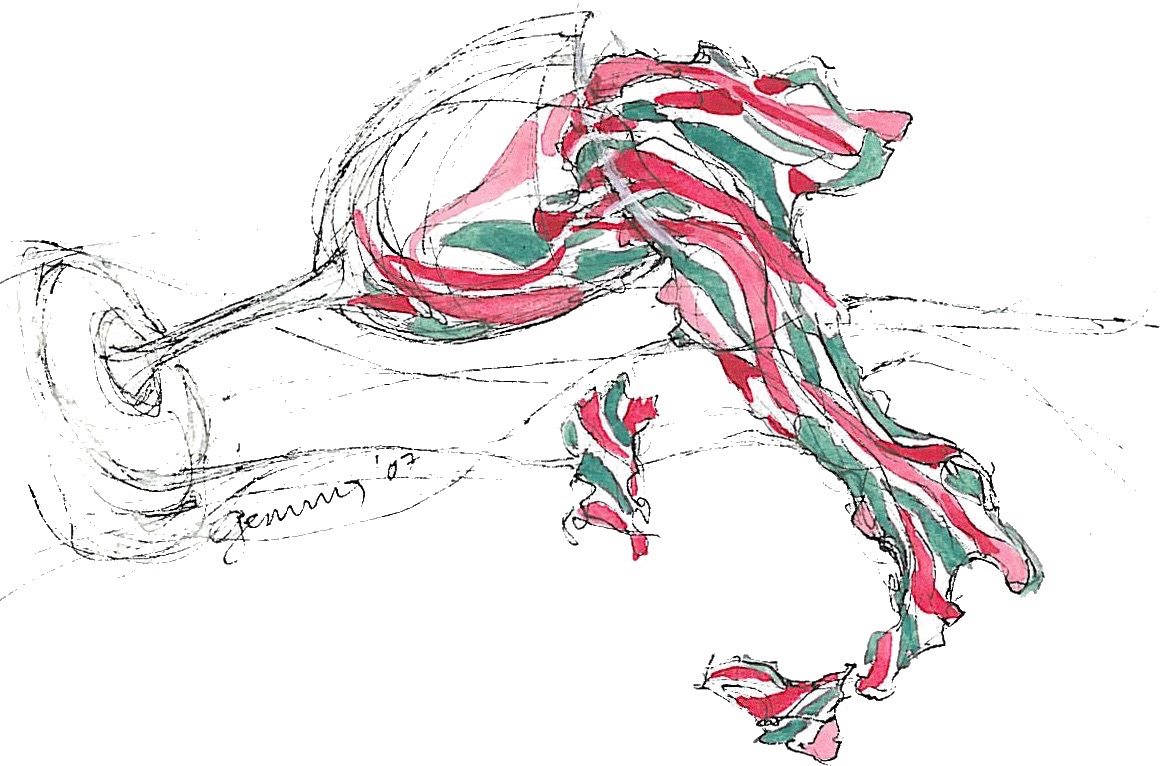
Maria
Empson is an artist who specializes in
work whose subject is wine.
China
continues
to be a difficult market for importers to
work with and make deals
with. Have you found this to be the case?
China is a
market which has come a long way in
a relatively short space of time.
The fastest area in this growth is
undoubtedly the knowledge and
appreciation for wine. As with
other
Asian markets, many Chinese have an ability to
understand different styles and
flavors very distinctly. This said, the
overall picture and “education” is still
in infancy, but with a growing middle income
bracket, interest for more serious
wines is definitely happening.
Due to the
size of China, together with its
diverse business models, consistent and
well planned distribution channels can be
still the biggest hurdle to overcome.
There are several very serious and
well-organized importers and distributors
for wine, but
there is a clear need for
many more with the amount of growth still
occurring today.
How do
you think global warming is affecting the
world’s vineyards within the next
five to ten years?
We’ve
already
witnessed a change over the last 10 years with
more high elevation vineyards
coming into the fold of top quality,
as well as seeing new “cooler climate” wine
growing areas gaining awards. This, however,
is partly due to a string of
particularly warm summers (e.g,
in
Europe) which may not repeat every year. To
see the real effects and new
possibilities created from global warming in
the world of viticulture, we’ll
need to monitor the averages for much longer
than 5 to 10 years.
This said,
each and every winery has a story to
tell on how global warming is playing a
role in the fast or slow term.
❖❖❖
WELL,
THAT'S SOMETHING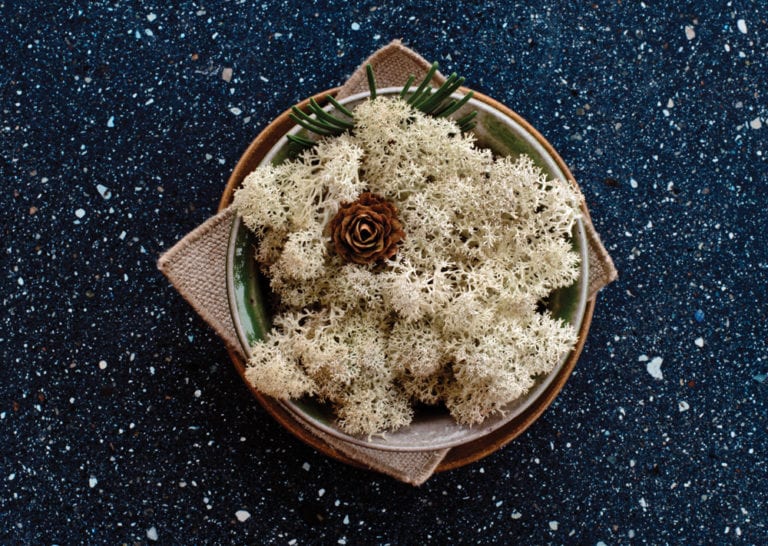
"The
fermented squirrel sauce in the first course of
Noma’s $500 game and forest menu last fall didn’t
taste anywhere near as
furry-woodland-rodent-forward as you might expect
(right)." –Chris
Nuttal Smith, “The Wizard of Noma,” Toronto Life
(2/19).
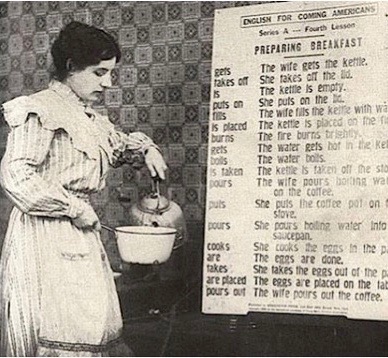 DON'T BLAME SPELLCHECK
DON'T BLAME SPELLCHECKIn the running for most misspellings on one menu: Sapori II, Scarsdale, NY:
• gfnocchi
• copa
• marieka gouda
• rigatoni bolognaise
• praire breaze
• calimari
• fillet mignon
Wine
Column Sponsored by Banfi Vintners
SANGIOVESE
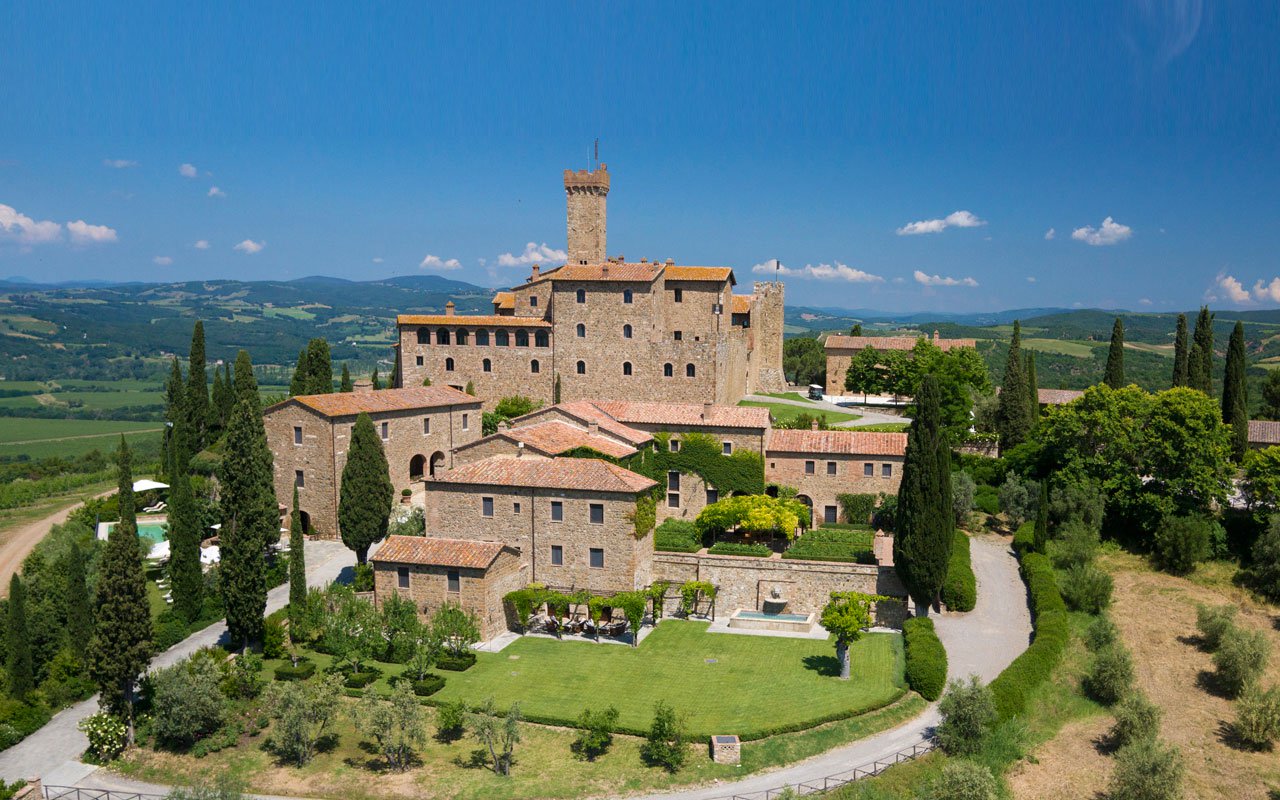 Wine is a joy year-round but
in cooler weather one
grape varietal has really taken center stage in
my daily activities – that most Italian of
grapes, Sangiovese, and its ultimate expression
– Brunello di Montalcino.
Wine is a joy year-round but
in cooler weather one
grape varietal has really taken center stage in
my daily activities – that most Italian of
grapes, Sangiovese, and its ultimate expression
– Brunello di Montalcino.
From mid-September through mid-October,
the Sangiovese grown for our various styles of red
wines are be harvested, culminating with the top
selection for Brunello di Montalcino.
Second, cooler weather here means
it is time to start enjoying more red wines and
especially Sangiovese based wines. That
includes Banfi’s cru of Brunello, Poggio alle Mura,
literally the cream of the crop of our Sangiovese
vineyards. Alongside our Poggio alle Mura Brunello di
Montalcino, this year we introduced two more wines
from the cru Poggio alle Mura – a Rosso di Montalcino
and a Riserva of Brunello. Rosso is sort of like the
younger brother of Brunello, also made from 100%
Sangiovese grapes but usually a selection from younger
vines and the wine is aged only two years compared to
the four required for Brunello. The
Riserva, on the other hand, is an even more selective
harvest of Sangiovese, and ages for an additional year
before release.
What is so special about this cru
Poggio alle Mura?
Well, it is the result our over 30 years of
ongoing research at my family’s vineyard estate,
Castello Banfi.
When we first began planting our vines there in
the late 1970s studies from the University of Bordeaux
indicated which strains of many varietals we should
plant, based on the soil type and microclimate of each
vineyard. But
when it came to the region’s native Sangiovese, there
was only local lore, no scientific research. So we took
it upon ourselves to figure out this vine, and set off
on three decades of incredibly detailed research.
We started
with 600 apparent variations on Sangiovese, because it
is so susceptible to variations in weather and soil,
and narrowed that down to 160 truly genetically
different clones.
We planted a vineyard with two rows of each
type, made wine from each of them, and charted the
differences – remember, you only get one chance a year
to make wine, so this took time.
It took about ten years to get some
concrete results, though we continue to experiment
today and always will – you never stop learning in
science and nature!
Once we determined which were the best,
complementary clones that could be planted together to
make the best Brunello, we chose to plant them in what
we determined to be the optimal vineyard sites. Coincidentally,
the best soils and climate conditions are in the
slopes surrounding the medieval fortress today known
as Castello Banfi, known since Etruscan times as
Poggio alle Mura – the walled hilltop. Hence the
name of our most special “cru” of Brunello,
representing a synthesis between tradition and
innovation.
Though the focus of this study was
our Brunello, all of our Sangiovese-based wines,
including the super Tuscans SummuS, Cum Laude, and
Centine, benefitted from this work. And that’s
the third reason for celebrating Sangiovese this
month, for the range of wonderful reds that usher us
into autumn! One
wine in particular was inspired by our research – the
BelnerO, a Sangiovese dominant blend with what I like
to call a kiss of Cabernet and a whisper of Merlot. We grow the
grapes a little differently for BelnerO than for
Brunello, make the wine with less oak aging and
released it earlier from the winery, providing a
counterpoint to Brunello and a lovely terroir-driven
wine in its own right.
If you
know Italians, you know that by nature we are
multi-faceted, varying in mood, and always passionate. As a
nation, we span from the hot sunny beaches of Sicily
near the African coast to the rugged mountains and
Alpine ski slopes of Trentino-Alto Adige in the north. Sangiovese
is grown in almost all of Italy’s regions and reflects
the unique nature of each; it is most famous
(rightfully so) in Tuscany, yet even there it reflects
the nuances of each hilltop, valley and subzone. It has
something a little different to say in Brunello than
Chianti, Morellino than Vino Nobile di Montepulciano,
Rosso di Montalcino than Super Tuscan blends.
Here is a smattering of
Sangiovese-based wines that you may wish to get to
know better, reflecting a spectrum that appeals to
every occasion, every taste, and every budget. We can
assure you that the conversation will never become
boring. 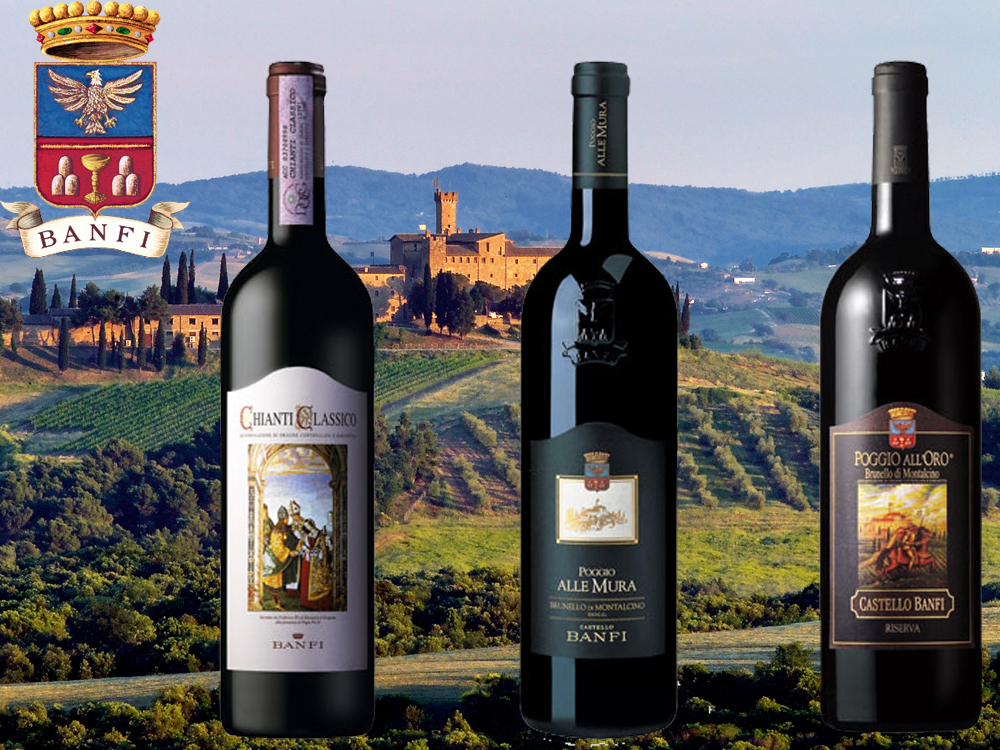
Recommendations for Celebrating
Sangiovese
BelnerO Proprietor’s Reserve Sangiovese
– A refined
cuvée of noble red grapes perfected by our pioneering
clonal research. This dark beauty, BelnerO, is
produced at our innovative winery, chosen 11
consecutive years as Italy’s Premier Vineyard Estate.
Fermented in our patented temperature controlled
French oak and aged approximately 2 additional years.
Unfiltered, and Nitrogen bottled to minimize sulfites.
Castello Banfi Brunello di Montalcino –
Rich, round, velvety and intensely
aromatic, with flavor hints of licorice, cherry, and
spices. Brunello di Montalcino possesses an intense
ruby-red color, and a depth, complexity and opulence
that is softened by an elegant, lingering aftertaste.
Unfiltered after 1998 vintage.
Castello Banfi Rosso di Montalcino – Brunello's "younger brother," produced
from select Sangiovese grapes and aged in barrique for
10 to 12 months. Deep ruby-red, elegant, vibrant,
well-balanced and stylish with a dry velvety
finish.
Poggio all’Oro Brunello di Montalcino
Riserva – A single vineyard selection of our most
historically outstanding Sangiovese, aged five years
before release, the additional year more than that
required of Brunello including 6 months in barrel and
6 months more in bottle to grant its “Riserva”
designation. Incredible
elegance and harmony. Intense with lots of fruit and
subtle wood influence. Round, complete, well balanced
with hints of chocolate and berries. Unfiltered after
1998.
Poggio alle Mura – The first tangible result of years of
intensive clonal research on Montalcino’s native
Sangiovese grape.
Estate bottled from the splendidly sun drenched
vineyards surrounding the medieval Castello from which
it takes its name.
The Brunello
di Montalcino is seductive, silky and smoky. Deep ruby
in color with an expressive bouquet of violets, fruits
and berries as well as cigar box, cedar and exotic
spices. The Rosso
di Montalcino is also intense ruby red. The bouquet
is fresh and fruity with typical varietal notes of
cherry and blackberry, enriched by more complex hints
of licorice, tobacco and hazelnut. It is full
bodied, yet with a soft structure, and a surprisingly
long finish. The Poggio alle Mura Brunello di Montalcino
Riserva is deep ruby red with garnet
reflections and a rich, ample bouquet that hints of
prune jam, coffee, cacao and a light balsamic note. It is full
and powerful, with ripe and gentle tannins that make
it velvety and harmonious; this wine is supported by a
pleasing minerality that to me speaks soundly of that
special hillside in southern Montalcino.
SummuS – A wine of towering elegance, SummuS is an
extraordinary blend of Sangiovese which contributes
body; Cabernet Sauvignon for fruit and structure; and
Syrah for elegance, character and a fruity bouquet. An elegant,
complex and harmonious red wine.
Cum Laude – A complex and elegant red which graduated
“With Honors,” characterized by aromas of juicy
berries and fresh spices.
Centine – A Cuvee that is more than half
Sangiovese, the balanced consisting of equal parts of
Cabernet Sauvignon and Merlot. Vinified in
a firm, round style that easily accompanies a wide
range of dishes, this is a smooth and fragrantly
satisfying wine with international character, and a
perennial favorite at my own dinner table.
Banfi Chianti Superiore – The “Superiore” designation signifies
stricter government regulations regarding production
and aging requirements, as compared to regular
Chianti. An
intense ruby red wine with fruit forward aromas and
floral notes. This
is a round wine with well-balanced acidity and fruit.
Banfi Chianti Classico – An enduring classic: alluring
bouquet of black fruit and violets; rich flavors of
cherry and leather; supple tannins and good acidity
for dining.
Banfi Chianti Classico Riserva – Produced from select grapes grown in the
"Classico" region of Chianti, this dry, fruity and
well-balanced red has a full bouquet reminiscent of
violets.
Fonte alla Selva Chianti Classico – This is our newest entry into the Chianti
arena, coming from a 99 acre estate in Castellina, the
heart of the Chianti Classico region. The wine is
a captivating mauve red that smells of cherry, plum
and blackberry with hints of spice. It is
round, full and balanced with very good
acidity.
Col di Sasso – Sangiovese and Cabernet Sauvignon. Luscious,
complex and soft with persistent notes of fruit and
great Italian style structure.
Any of John Mariani's books below may be ordered from amazon.com.
 The Hound in Heaven
(21st Century Lion Books) is a novella, and
for anyone who loves dogs, Christmas, romance,
inspiration, even the supernatural, I hope you'll find
this to be a treasured favorite. The story
concerns how, after a New England teacher, his wife and
their two daughters adopt a stray puppy found in their
barn in northern Maine, their lives seem full of promise.
But when tragedy strikes, their wonderful dog Lazarus and
the spirit of Christmas are the only things that may bring
his master back from the edge of despair.
The Hound in Heaven
(21st Century Lion Books) is a novella, and
for anyone who loves dogs, Christmas, romance,
inspiration, even the supernatural, I hope you'll find
this to be a treasured favorite. The story
concerns how, after a New England teacher, his wife and
their two daughters adopt a stray puppy found in their
barn in northern Maine, their lives seem full of promise.
But when tragedy strikes, their wonderful dog Lazarus and
the spirit of Christmas are the only things that may bring
his master back from the edge of despair. WATCH THE VIDEO!
“What a huge surprise turn this story took! I was completely stunned! I truly enjoyed this book and its message.” – Actress Ali MacGraw
“He had me at Page One. The amount of heart, human insight, soul searching, and deft literary strength that John Mariani pours into this airtight novella is vertigo-inducing. Perhaps ‘wow’ would be the best comment.” – James Dalessandro, author of Bohemian Heart and 1906.
“John Mariani’s Hound in Heaven starts with a well-painted portrayal of an American family, along with the requisite dog. A surprise event flips the action of the novel and captures us for a voyage leading to a hopeful and heart-warming message. A page turning, one sitting read, it’s the perfect antidote for the winter and promotion of holiday celebration.” – Ann Pearlman, author of The Christmas Cookie Club and A Gift for my Sister.
“John Mariani’s concise, achingly beautiful novella pulls a literary rabbit out of a hat – a mash-up of the cosmic and the intimate, the tragic and the heart-warming – a Christmas tale for all ages, and all faiths. Read it to your children, read it to yourself… but read it. Early and often. Highly recommended.” – Jay Bonansinga, New York Times bestselling author of Pinkerton’s War, The Sinking of The Eastland, and The Walking Dead: The Road To Woodbury.
“Amazing things happen when you open your heart to an animal. The Hound in Heaven delivers a powerful story of healing that is forged in the spiritual relationship between a man and his best friend. The book brings a message of hope that can enrich our images of family, love, and loss.” – Dr. Barbara Royal, author of The Royal Treatment.
 |
The Encyclopedia of American Food and Drink by John F. Mariani (Bloomsbury USA, $35) Modesty forbids me to praise my own new book, but let me proudly say that it is an extensive revision of the 4th edition that appeared more than a decade ago, before locavores, molecular cuisine, modernist cuisine, the Food Network and so much more, now included. Word origins have been completely updated, as have per capita consumption and production stats. Most important, for the first time since publication in the 1980s, the book includes more than 100 biographies of Americans who have changed the way we cook, eat and drink -- from Fannie Farmer and Julia Child to Robert Mondavi and Thomas Keller. "This book is amazing! It has entries for everything from `abalone' to `zwieback,' plus more than 500 recipes for classic American dishes and drinks."--Devra First, The Boston Globe. "Much needed in any kitchen library."--Bon Appetit. |
"Eating Italian will never be the same after reading John Mariani's entertaining and savory gastronomical history of the cuisine of Italy and how it won over appetites worldwide. . . . This book is such a tasteful narrative that it will literally make you hungry for Italian food and arouse your appetite for gastronomical history."--Don Oldenburg, USA Today. "Italian
restaurants--some good, some glitzy--far
outnumber their French rivals. Many of
these establishments are zestfully described
in How Italian Food Conquered the World, an
entertaining and fact-filled chronicle by
food-and-wine correspondent John F.
Mariani."--Aram Bakshian Jr., Wall Street
Journal.
"Equal parts
history, sociology, gastronomy, and just
plain fun, How Italian Food Conquered the
World tells the captivating and delicious
story of the (let's face it) everybody's
favorite cuisine with clarity, verve and
more than one surprise."--Colman Andrews,
editorial director of The Daily
Meal.com. "A fantastic and fascinating
read, covering everything from the influence
of Venice's spice trade to the impact of
Italian immigrants in America and the
evolution of alta cucina. This book will
serve as a terrific resource to anyone
interested in the real story of Italian
food."--Mary Ann Esposito, host of PBS-TV's
Ciao
Italia. "John Mariani has written the
definitive history of how Italians won their
way into our hearts, minds, and
stomachs. It's a story of pleasure over
pomp and taste over technique."--Danny Meyer,
owner of NYC restaurants Union Square
Cafe, The Modern, and Maialino.
|
 |
 |
 |
 |
 |
 |
 |
 |
 Everett Potter's Travel Report:
Everett Potter's Travel Report: 
 Eating Las Vegas
JOHN CURTAS has been covering the Las Vegas
food and restaurant scene since 1995. He is
the co-author of EATING LAS VEGAS – The 50
Essential Restaurants (as well as
the author of the Eating Las Vegas web site: www.eatinglasvegas.
He can also be seen every Friday morning as
the “resident foodie” for Wake Up With the
Wagners on KSNV TV (NBC) Channel 3 in
Las Vegas.
Eating Las Vegas
JOHN CURTAS has been covering the Las Vegas
food and restaurant scene since 1995. He is
the co-author of EATING LAS VEGAS – The 50
Essential Restaurants (as well as
the author of the Eating Las Vegas web site: www.eatinglasvegas.
He can also be seen every Friday morning as
the “resident foodie” for Wake Up With the
Wagners on KSNV TV (NBC) Channel 3 in
Las Vegas.
MARIANI'S VIRTUAL GOURMET
NEWSLETTER is published weekly. Publisher: John Mariani. Editor: Walter Bagley. Contributing Writers: Christopher Mariani,
Robert Mariani, Misha Mariani, John A. Curtas, Gerry Dawes, Geoff Kalish,
and Brian Freedman. Contributing
Photographer: Galina Dargery. Technical
Advisor: Gerry
McLoughlin.
If you wish to subscribe to this
newsletter, please click here: http://www.johnmariani.com/subscribe/index.html
© copyright John Mariani 2019

